Excel 2000 -
Using the Page Setup Dialog Box

Excel 2000
Using the Page Setup Dialog Box


/en/excel2000/editing-charts/content/
Before you print your spreadsheet, you will want to define page orientation, paper size, print quality, margins, sheet settings, and headers and footers.
The Page Setup dialog box includes four tabs to help you do this:
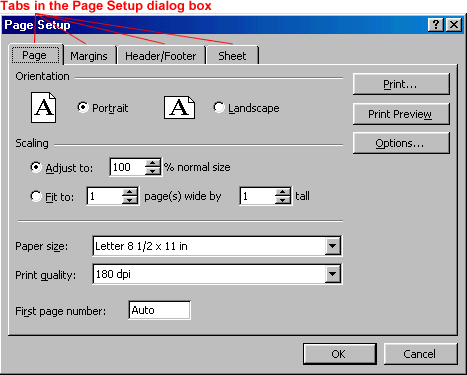
If your spreadsheet is wider than it is tall, change the page orientation or paper size.
The default paper size is 8.5x11 inches, or portrait. Changing to landscape orientation prints the longer side of the paper at the top (11x8.5 inches), allowing room for extra columns.
THEN
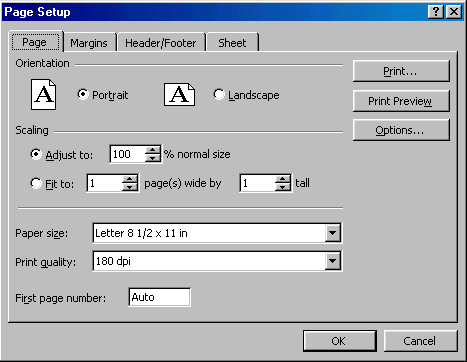
![]() You can shrink spreadsheet data so it fits on a specified number of pages when you print. Click the Page tab, click the Fit to: option button, and enter the desired number of pages wide and pages tall.
You can shrink spreadsheet data so it fits on a specified number of pages when you print. Click the Page tab, click the Fit to: option button, and enter the desired number of pages wide and pages tall.
![]() Print quality is measured in dpi, or dots per inch. High dpi gives you a higher resolution and a better print quality. However, it takes longer to print.
Print quality is measured in dpi, or dots per inch. High dpi gives you a higher resolution and a better print quality. However, it takes longer to print.
By default, the top and bottom margins are set at 1 inch. The left and right margins are set at 0.75 inch. You can change these margins using the Page Setup dialog box's Margins tab.
Margins display as dotted lines. Use the spin box controls to determine the size of each margin.
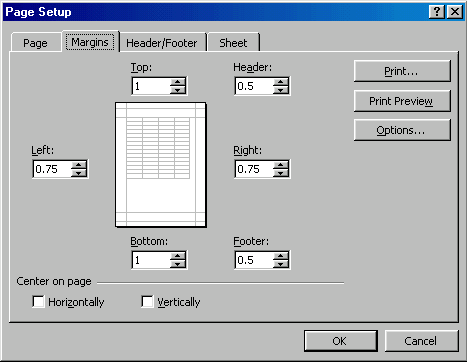
 Page Setup from the menu bar.
Page Setup from the menu bar.A header is a title that appears at the top of each page of a document. Footers are printed at the bottom of the page. Headers and footers display in the 0.5-inch space between the header and footer margin and the regular margin. The default setting is no header and no footer.
If you want to add a header and/or footer to your spreadsheet, you can do so using the Page Setup dialog box's Header/Footer tab.
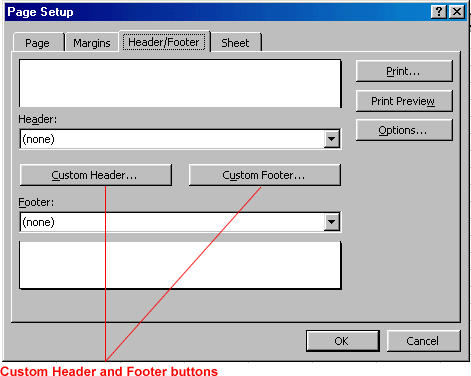
 Page Setup from the menu bar.
Page Setup from the menu bar.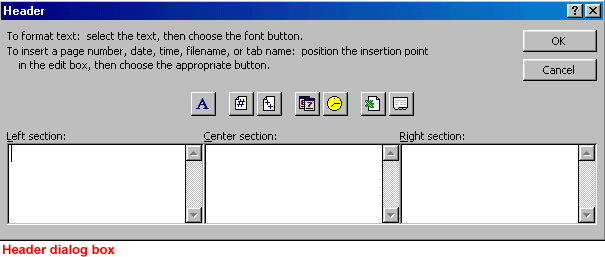
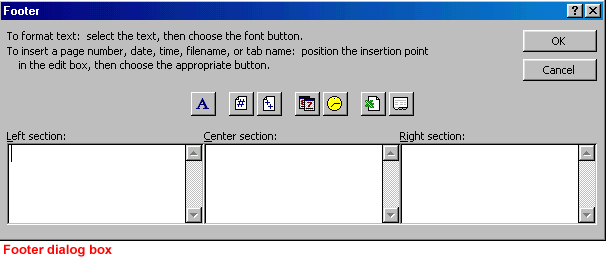
In the Header/Footer dialog box, there are a series of placeholder buttons you can ignore or use to format text, insert page numbers, date, time, file name, and tab name.

To insert a page number, date, time, file name, or tab name, position the insertion point in the appropriate text box, then choose the appropriate button.
When the file is printed, Excel will replace placeholders with those you selected. Click OK to return to the Page Setup dialog box.
Select text and click the Font button to format header and footer text. Click OK to return to the Page Setup dialog box.
Button | Button Name | Function of Placeholder |
 | Page Number | Current page number |
 | Total Pages | Total pages printed |
 | Date | Date worksheet printed |
 | Time | Time worksheet printed |
 | File Name | Name of workbook |
 | Tab | Name of worksheet |
The Page Setup dialog box's Sheet tab allows you to consider other options for your worksheet, such as whether to print gridlines or row and column headings.

By default, Excel prints from A1 to the last occupied cell in a worksheet. You can specify a different range of cells to print.
This feature prints column and row labels on each page of the printout. Specify these rows or columns in the Rows to Repeat at Top and Columns to Repeat at Left text boxes.
This determines whether gridlines are printed. However, turning off gridlines does not affect their appearance in Normal view.
Choose draft quality to print a worksheet without gridlines or graphics.
If you used colors in your worksheet but don't want to waste the ink in your color printer, use black and white.
Click this option to include row numbers and column letters in your printed document.
This determines the order in which worksheets are printed.
 To turn off gridlines, you can also choose Tools
To turn off gridlines, you can also choose Tools Options from the menu bar. Click the View tab and uncheck the gridlines option.
Options from the menu bar. Click the View tab and uncheck the gridlines option.
When you return to Normal view, don't be alarmed if you don't see your header and footer displayed in your spreadsheet. When you print, Excel places your header and footer in your spreadsheet. You can preview your headers and footers, margins, and page orientation using Print Preview.
/en/excel2000/print-preview/content/